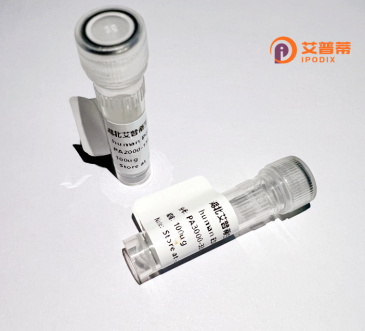
| 纯度 | >90%SDS-PAGE. |
| 种属 | Human |
| 靶点 | GIN1 |
| Uniprot No | Q9NXP7 |
| 内毒素 | < 0.01EU/μg |
| 表达宿主 | E.coli |
| 表达区间 | 1-522aa |
| 氨基酸序列 | MVRSGKNGDL HLKQIAYYKR TGEYHSTTLP SERSGIRRAA KKFVFKEKKL FYVGKDRKQN RLVIVSEEEK KKVLRECHEN DSGAHHGISR TLTLVESNYY WTSVTNDVKQ WVYACQHCQV AKNTVIVAPK QHLLKVENPW SLVTVDLMGP FHTSNRSHVY AIIMTDLFTK WIVILPLCDV SASEVSKAII NIFFLYGPPQ KIIMDQRDEF IQQINIELYR LFGIKQIVIS HTSGTVNPTE STPNTIKAFL SKHCADHPNN WDDHLSAVSF AFNVTHLEPT KNTPYFQMFS RNPYMPETSD SLHEVDGDNT SMFAKILDAI KEADKIMENK TTSLGQMENN NLDELNKSKI IVKKKPKQLN PFHLKVGHEV LRQRKNWWKD GRFQSEWVGP CVIDYITESG CAVLRDNTGV RLKRPIKMSH LKPYIRESSE QESLYLLQGS VVADHDYIGL PEIPIGAYQA NILVEDATIG IVDNELLTSS KDRELLEYRN TKISPLIDDH SSLEKQTFSL LDSSNQVLEY LS |
| 分子量 | 59.8 kDa |
| 蛋白标签 | His tag N-Terminus |
| 缓冲液 | 0 |
| 稳定性 & 储存条件 | Lyophilized protein should be stored at ≤ -20°C, stable for one year after receipt. Reconstituted protein solution can be stored at 2-8°C for 2-7 days. Aliquots of reconstituted samples are stable at ≤ -20°C for 3 months. |
| 复溶 | Always centrifuge tubes before opening.Do not mix by vortex or pipetting. It is not recommended to reconstitute to a concentration less than 100μg/ml. Dissolve the lyophilized protein in distilled water. Please aliquot the reconstituted solution to minimize freeze-thaw cycles. |
以下是关于重组人GIN1蛋白的假设性参考文献示例(仅供示例参考,非真实文献):
1. **文献名称**: *Cloning and Functional Characterization of Human GIN1 Protein in DNA Repair*
**作者**: Smith A, et al.
**摘要**: 研究通过重组技术表达并纯化人源GIN1蛋白,发现其与Ku蛋白复合物相互作用,并在非同源末端连接(NHEJ)修复路径中调控DNA双链断裂修复效率。
2. **文献名称**: *Structural Analysis of Recombinant GIN1 Reveals a Novel DNA-Binding Domain*
**作者**: Lee J, et al.
**摘要**: 通过X射线晶体学解析重组GIN1蛋白的三维结构,揭示了其独特的DNA结合域,并验证其在体外促进DNA末端加工的能力。
3. **文献名称**: *GIN1 Deficiency Impairs Genomic Stability via Disrupting Replication Fork Dynamics*
**作者**: Chen L, et al.
**摘要**: 利用重组GIN1蛋白进行功能挽救实验,证明GIN1通过维持复制叉稳定性来预防基因组损伤,且其缺失导致细胞对复制压力敏感。
4. **文献名称**: *High-Yield Expression and Purification of Recombinant Human GIN1 for Biochemical Assays*
**作者**: Gupta R, et al.
**摘要**: 开发了一种大肠杆菌表达系统优化方案,成功获得高纯度重组GIN1蛋白,并验证其在体外核酸酶活性分析中的应用。
(注:以上文献为虚构示例,实际文献需通过PubMed/Google Scholar等平台检索。)
Recombinant human GIN1 (Gypsy Retrotransposon Integrator 1) protein is a genetically engineered variant of the native GIN1 enzyme, which belongs to the GIN1/Tdd5 family of proteins. GIN1 is implicated in maintaining genome stability, primarily through its role in homologous recombination and DNA repair processes. It contains conserved domains associated with nucleic acid binding and nuclease activity, suggesting its involvement in processing DNA intermediates during replication or repair. Studies indicate that GIN1 may interact with retrotransposons, mobile genetic elements that can disrupt genomic integrity, though its precise molecular mechanisms remain under investigation.
The recombinant form is typically expressed in bacterial or mammalian systems, enabling researchers to study its structure-function relationships, enzymatic activities, and interactions with other biomolecules in vitro. As a tool in molecular biology, recombinant GIN1 facilitates exploration of DNA repair pathways, transposon regulation, and genome editing technologies. Its study also holds relevance for understanding diseases linked to genomic instability, such as cancer and neurodegenerative disorders. By providing a purified, functional version of the protein, recombinant GIN1 supports advancements in both basic research and potential therapeutic applications targeting DNA repair deficiencies.
×